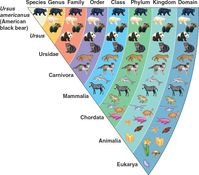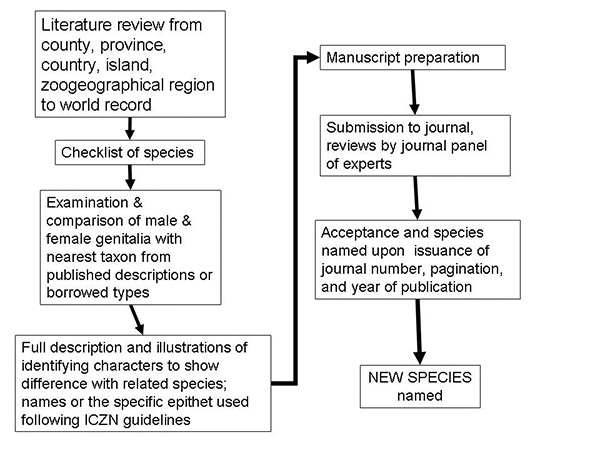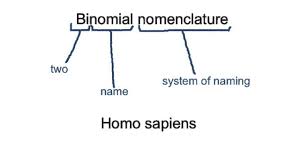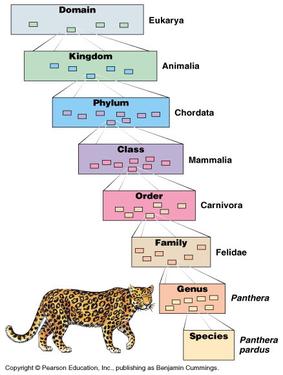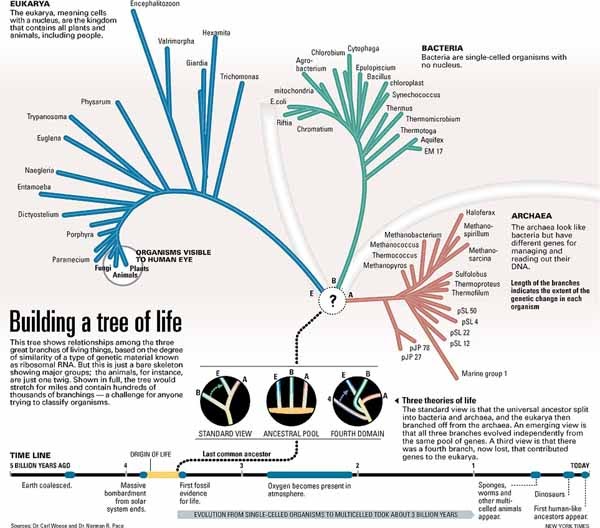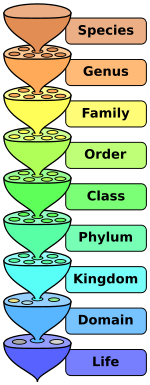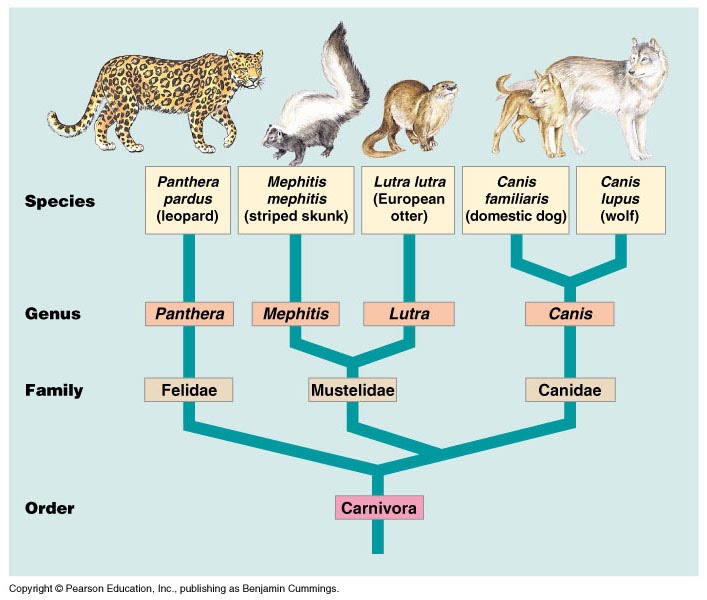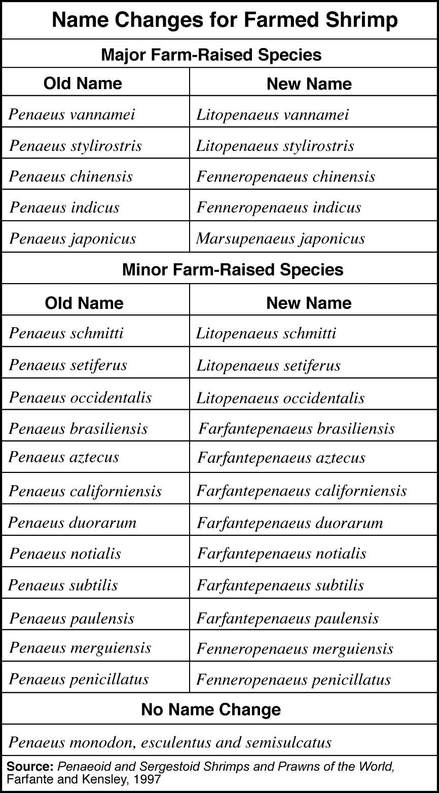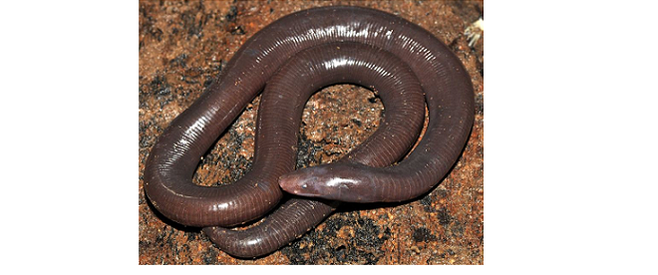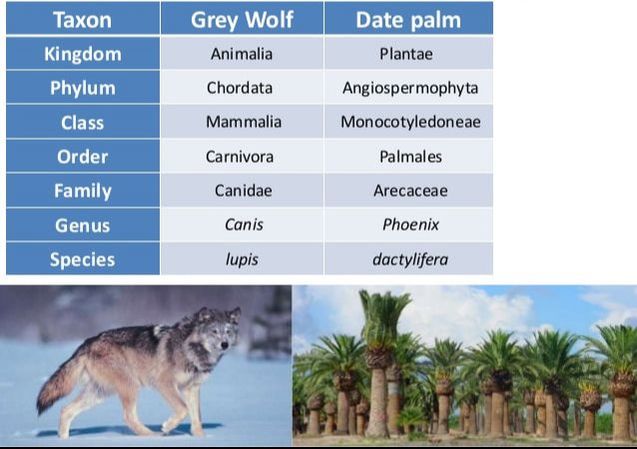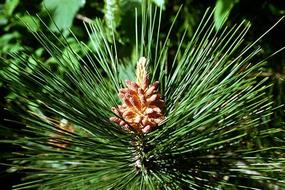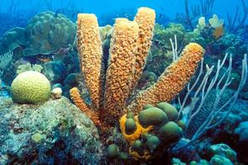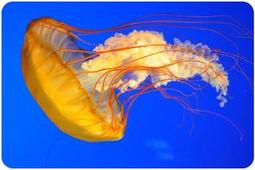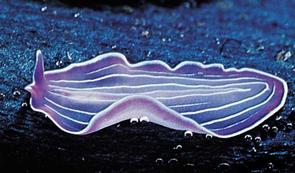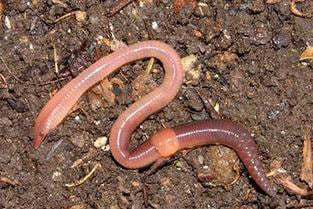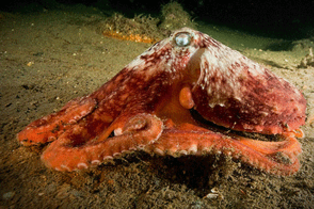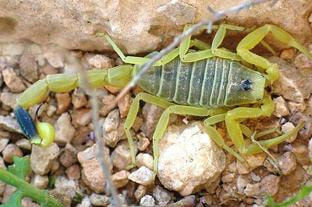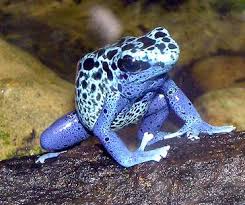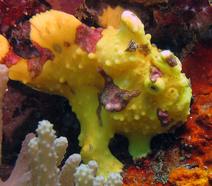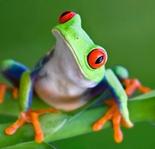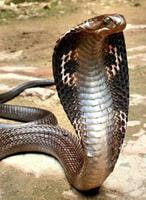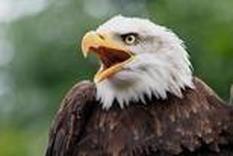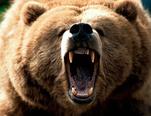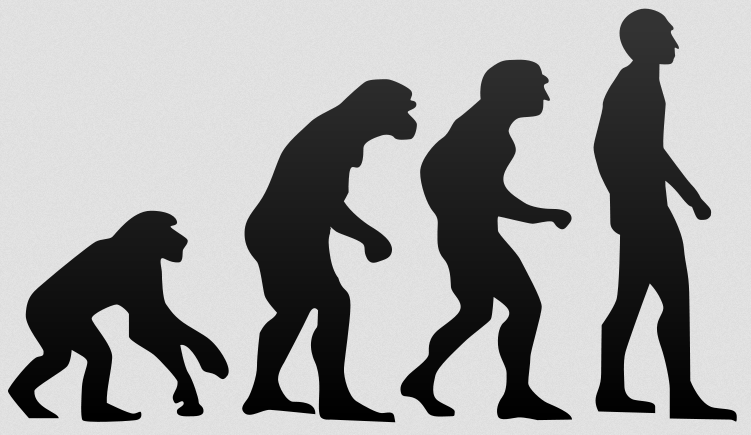- IB Style Question Banks with Solution
- IB DP Biology SL- IB Style Practice Questions with Answer-Topic Wise-Paper 1
- IB DP Biology HL- IB Style Practice Questions with Answer-Topic Wise-Paper 1
- IB DP Biology SL- IB Style Practice Questions with Answer-Topic Wise-Paper 2
- IB DP Biology HL- IB Style Practice Questions with Answer-Topic Wise-Paper 2
5.3 Classification of Biodiversity
Essential Idea:
Species are named and classified using an internationally agreed system
Understandings:
- The binomial system of names for species is universal among biologists and has been agreed and developed at a series of congresses
- When species are discovered they are given scientific names using the binomial system
- All organisms are classified into three domains
- Taxonomists classify species using a hierarchy of taxa
- The principal taxa for classifying eukaryotes are kingdom, phylum, class, order, family, genus and species
- In a natural classification, the genus and accompanying higher taxa consists of all the species that have evolved from one common ancestral species
- Taxonomists sometimes reclassify groups of species when new evidence shows that a previous taxon contains species that have evolved from different ancestral species
- Natural classifications help in identification of species and allow the prediction of characteristics shared by species within a group
Applications:
- Classification of one plant and one animal species from domain to species level
- Recognition features of bryophyta, filicinophyta, coniferophyta and angiospermophyta
- Recognition features of porifera, cnidaria, platyhelmintha, annelida, mollusca, arthropoda and chordata
- Recognition features of birds, mammals, amphibians, reptiles and fish
Skills
- Construction of dichotomous keys for use in identifying specimens
- Outline the role of botanical and zoological congresses in the naming of plants and animals.
- Define binomial nomenclature.
- State three rules of binomial nomenclature formatting.
- Define taxon and taxonomist.
- List the hierarchy of taxa, from largest to smallest.
- State the two groups of prokaryotes.
- List the three domains of life.
- Outline differences between the three domains of life.
- Draw a tree diagram to illustrate the evolutionary relationship between organisms of the three domains.
- List the four kingdoms of eukaryotes.
- List the hierarchy of taxa, from largest to smallest.
- Define natural classification.
- List two difficulties in determining the natural classification of species.
- List two situations in which the reclassification of a species may be necessary.
- Outline an example of a species (or group of species) which were reclassified when new evidence was discovered.
- Explain two specific advantages of natural classification.
- State the classification of a plant, from domain to species.
- State the classification of an animal, from domain to species.
- State the four major plant phyla.
- Outline the differences between the four major plant phyla in regard to external recognition features.
- Identify the phyla of plant given external recognition features.
- State seven major animal phyla.
- Outline the characteristics of seven major animal phyla.
- Identify the phyla of animal given external recognition features.
- Contrast chordate and vertebrate.
- State five major classes of chordata.
- Outline the characteristics of five major vertebrate classes.
- Identify the vertebrate class of animal given external recognition features.
- Explain the use of a dichotomous key in the identification of a specimen.
- Create a dichotomous key given a sample of known specimens.
- Outline why the binomial naming system is used in science rather than local names.
- State the role of Carl Linnaeus in naming species.
Topic 5.3: classification and biodiversity
In the unit of Classification of biodiversity you will how the Swedish botanist Carolus Linnaeus originally invented the binomial system to help him consistently name plants he identified. The system was eventually adopted by other scientists and remains to the accepted naming system for species. Though species may have many common names to avoid confusion scientists always use the (scientific) binomial name.
This unit will last 4 school days
Essential idea:
- Species are named and classified using an internationally agreed system.
Nature of science:
- Cooperation and collaboration between groups of scientists—scientists use the binomial system to identify a species rather than the many different local names. (4.3)
- Outline why the binomial naming system is used in science rather than local names.
- State the role of Carl Linnaeus in naming species.
5.3.U1 The binomial system of names for species is universal among biologists and has been agreed and developed at a series of congresses.
- Outline the role of botanical and zoological congresses in the naming of plants and animals.
The binomial system of nomenclature is the formal system by which all living species are classified (taxonomy). It was initially developed by a Swedish botanist named Carolus Linnaeus in 1735.
- Normal two naming system of classifying species.
- Currently, many scientists and specialists meet in a series of International Congresses of Zoology which meet in different cities every 4 years
- They meet to discuss their findings regarding genetics, animal behaviour and classification
- A main topic is the binomial nomenclature system and decisions regarding the classification of new organisms or the reclassification of old ones because of new evidence regarding ancestry.
The binomial system of nomenclature provides value because:
- It allows for the identification and comparison of organisms based on recognised characteristics
- It allows all organisms to be named according to a globally recognised scheme
- It can show how closely related organisms are, allowing for the prediction of evolutionary links
- It makes it easier to collect, sort and group information about organisms
5.3.U2 When species are discovered they are given scientific names using the binomial system
- Define binomial nomenclature.
- State three rules of binomial nomenclature formatting.
A formal two naming system of classifying species. The first name in the binomial naming system is called the genus and is always capitalized. The second name starts with a small letter and is called the species.
The binomial system allows for scientists across cultures, regions and languages to communicate effectively with regards to specific organisms.
species = the natural basic grouping of organisms
- a group of organisms with similar characteristics
- which can interbreed
- and produce fertile offspring
genus = every species is calssified into a genus
- a group of similar species
binomial nomenclature
- first name = genus, written in italics, if in type, or underlined if not, with the first letter in upper case
- second name = species, written in italics, if in type, or underlined if not, all letters in lower case
5.3.U3 Taxonomists classify species using a hierarchy of taxa.
- Define taxon and taxonomist.
- List the hierarchy of taxa, from largest to smallest.
Taxonomy is the science involved with classifying groups of organisms on the basis of shared characteristics. Organisms are grouped according to a series of hierarchical taxa – the more taxa organisms share, the more similar they are.
The taxa used are kingdom, phylum, class, order, family, genus and species (genus + species = scientific name)
- A taxon means a group of something
- Scientists arrange or organize species in to a hierarchical set of groups in order to organize organisms into specific similar groups based on similar characteristics
- As one goes higher up on a classification chart, the greater the number of species are included into the group
[Archaea, eubacteria and eukaryote should be used for the three domains. Members of these domains should be referred to as archaeans, bacteria and eukaryotes. Viruses are not classified as living organisms.]
- State the two groups of prokaryotes.
- List the three domains of life.
- Outline differences between the three domains of life.
- Draw a tree diagram to illustrate the evolutionary relationship between organisms of the three domains.
Currently, all living organisms are classified into three domains. Archaea, eubacteria and eukaryote should be used for the three domains:
- Eukarya – eukaryotic organisms that contain a membrane-bound nucleus (includes protist, plants, fungi and animals)
- Archaea – prokaryotic cells lacking a nucleus and consist of the extremophiles (e.g. methanogens, thermophiles, etc.)
- Eubacteria – prokaryotic cells lacking a nucleus and consist of the common pathogenic forms (e.g. E. coli, S. aureus, etc.)
Members of these domains should be referred to as archaeans, bacteria and eukaryotes.
- The Archaea and Bacteria domains are prokaryotes. These are organisms that do not have a membrane bound nucleus and their DNA is not associated with proteins.
- The Bacteria domain consists of Eubacteria and archaebacteria are classified as Archaeans.
- The Eukarya domain includes eukaryotes, or organisms that have a membrane bound nucleus. This domain is further subdivided into the kingdoms Protista, Fungi, Plantae, and Animalia
- Groups organisms primarily based on differences in ribosomal RNA structure. Ribosomal RNA is a molecular building block for ribosomes.
5.3.U5 The principal taxa for classifying eukaryotes are kingdom, phylum, class, order, family, genus and species.
- List the four kingdoms of eukaryotes.
- List the hierarchy of taxa, from largest to smallest.
5.3.U6 In a natural classification, the genus and accompanying higher taxa consist of all the species that have evolved from one common ancestral species.
- Define natural classification.
- List two difficulties in determining the natural classification of species.
5.3.U7 Taxonomists sometimes reclassify groups of species when new evidence shows that a previous taxon contains species that have evolved from different ancestral species.
- List two situations in which the reclassification of a species may be necessary.
- Outline an example of a species (or group of species) which were reclassified when new evidence was discovered
5.3.U8 Natural classifications help in identification of species and allow the prediction of characteristics shared by species within a group.
- Explain two specific advantages of natural classification.
Historically, there have been two main classification schemes used to identify living organisms – artificial and natural classification. Both use prominent features as the basis for classification, however differ in the way these characteristics are established
- Artificial classification involves arbitrarily selecting unifying characteristics first and then grouping organisms accordingly
- Natural classification involves grouping organisms based on similarities first and then identifying shared characteristicsA third type of classification – phylogenetic classification – is now being used to differentiate organisms based on genetics
Natural classification is very useful for research into biodiversity. It is easier in identification of new species that do not obviously fit into a specific classification (Kingdom –> Phylum –> Class à etc.)
- A dichotomous key could be used to put an organism into a classification that fits that organism the best
- This would not work as well for artificial classification (eg. Colour of flower petals)
- Since organism evolved from a common ancestor, new species would share similar characteristics (likely internal), allowing for easier identification and classification. For example the pentadactyl limb, or mammary glands in mammals
HINT 2: It’s scientific name is Ichthyophis cardamomensis
HINT 3: It belongs to the CLASS Amphibia
Why use classification?
- Practicality – easy to use and speeds up communication
- Information Content – summarization of characteristics about organisms in a species and makes it easy to find
- Predictivity – can be used to predict features of other organisms within the group.
A 5.3.1 Classification of one plant and one animal species from domain to species level.
- State the classification of a plant, from domain to species.
- State the classification of an animal, from domain to species.
[Students should know which plant phyla have vascular tissue, but other internal details are not required.]
- State the four major plant phyla.
- Outline the differences between the four major plant phyla in regard to external recognition features.
- Identify the phyla of plant given external recognition features.
bryophyta: mosses
| filicinophyta: ferns
| coniferophyta: conifers
|

angiospermophyta: flowering plants
- have roots, leaves and stems all containing vascular tissue
- maximum height = 100 m
- reproductive structures:
- flowers, containing female pistil and/or male stamen
- male stamens produce pollen
- female pistils produce ovaries containing eggs
- seeds develop from fertilized eggs with in ovules
- fruits develop from ovaries to disperse seeds
.(Recognition features expected for the selected animal phyla are those that are most useful in distinguishing the groups from each other and full descriptions of the characteristics of each phylum are not needed.]
- State seven major animal phyla.
- Outline the characteristics of seven major animal phyla.
- Identify the phyla of animal given external recognition features
porifera: sponges
| cnidaria: corals, jellyfish, anemones
| playhelminthes: flat worms
|
annelida: segmented worms
| mollusca: slugs, snail, clams, squids
| arthropoda: insects, spiders, crabs, millipedes
|
chordata: fish, amphibians, reptiles, birds, mammals
|
|
|
A 5.3.4 Recognition of features of birds, mammals, amphibians, reptiles and fish
- Contrast chordate and vertebrate.
- State five major classes of chordata.
- Outline the characteristics of five major vertebrate classes.
- Identify the vertebrate class of animal given external recognition features.
Fish (Pisces)
| Amphibians (Amphibia)
| Reptiles (Reptilia)
|
Birds (Aves)
| Mammals (Mammalia)
|
S 5.3.1 Construction of dichotomous keys for use in identifying specimens.
- Explain the use of a dichotomous key in the identification of a specimen.
- Create a dichotomous key given a sample of known specimens.
A dichotomous key is a key constructed from a series of statements arranged into pairs..
- The two descriptions should represent separate choices or characteristics that determine the difference between two organisms.
- Both choices are read and compared with the organism to be identified.
- If the first characteristic is present in the organism to be identified follow the instructions at the end of the statement. If the characteristic is not present go to the second statement as this should be true.
- Once a choice is made, that selection directs you to another pair of descriptive statements.
- One statement might identify the organism or lead you further on in the key.
- This process is repeated until a successful identification is obtained.
Example for the Kingdom Animalia (using some of the characteristics from the above)
Symmetry
- Has bilateral symmetry go to 2
- Has radial symmetry go to 3
Digestive
- Has mouth and anus go to 4
- Has only one opening for mouth and anus go to 5
Exoskeleton
- Secretes hard exoskeleton made from CaCO3 Stony corals
- Soft exoskeleton go to 6
Body structure
- Has segmented body go to 7
- No segmentation with mantle Octopus
Mouth
- Has suckers and hooks for attachment Tapeworm
- No suckers or hooks Planaria
Locomotion
- Move on surface beneath it by an adhesive foot Sea Anemone
- Move by propulsion of water Jellyfish
Exoskeleton
- Hard exoskeleton with jointed appendages Scorpion
- Soft outer skeleton with bristles Earthworm
Evolution
Table of Content
- Definition of Evolution
- Example of Evolution
- Mechanism of Evolution
- Natural Selection
- Types of Natural Selection
- Darwin’s Theory of Evolution
- Modern understanding
- Evolutionary Change
- Human Evolution
- Frequently Asked Questions
Definition of Evolution
“Evolution is change in the heritable characteristics of biological populations over successive generations. Evolutionary processes give rise to biodiversity at every level of biological organization, including the levels of species, individual organisms, and molecules.”
Example of Evolution
Peppered moth initially had light colored which was darkened after Industrial Revolution, due to population. This mutation occurred because light colored moths were easily seen by birds, therefore, darkening of them helped in surviving from birds.
Example of Evolution and Mechanism of Evolution
“Microevolution refers to the change in allele frequencies within a single population.” Allele frequencies changes due to four major forces of evolution, i.e. Natural Selection, Genetic Drift, Mutation and Gene Flow.
What drives evolution: Mutation or Genetic Recombination?
Mutation and genetic recombination are the two possible sources that results in genetic variability. “Mutations are random nucleotide alterations such as copying errors or changes induced due to external mutagens.” On contrary, “genetic recombination is performed by the cell during the preparation of gametes (pollen, egg or sperm) that are used during sexual reproduction.”
Both of these processes contribute to the evolution of an organism but genetic recombination is considered as the primary source of enabling genetic distinctions between individuals in a population and is therefore, considered as principal driving force that results in evolution.
Natural Selection
Natural selection is the basic mechanism of evolution along with migration, mutation and genetic drift.
Definition of Natural Selection
“The process whereby organisms better adapted to their environment tend to survive and produce more offspring is referred as natural selection.” The adaptation takes place by means of selectively reproducing changes in its genetic constitution.
Example of Natural Selection
Tree frogs are sometimes eaten by birds and snakes. Amongst these grey tree frogs blend well in the areas with dark wood tree bark while green tree frogs blend well with green vegetation found in swamp and marshes.
A green tree frog on bark of tree is easy to be found by predator as compared to a green tree frog on green leaves. So, natural selection has favored those tree frogs that live in habitats in which they are more camouflaged.
In natural selection, the variations in genotype which increases the chances of survival of an organism and procreation are retained and multiplied in generations at the expense of less advantageous ones. Thus, natural selection arises from the differences in survival in rate of development, in fertility, in mating success and several other aspects. These all differences result in natural selection to the extent that they impact the number of progeny.
Gene frequencies remain constant in different generations in the absence of any disturbing factors. The factors that can create disturbances are migration (gene flow), mutation and random genetic drift.
Types of Natural Selection
- Stabilizing Selection – “When selective pressures select against the two extremes of a trait, the population experiences stabilizing selection.” Let us consider an example of plant height. A plant that is too short is not able to compete with other plants while the extremely tall plant may be more susceptible to wind damage. When these two selection pressures are combined, it helps in maintaining the medium plant height. As a result of stabilizing selection, the number of plants with medium height will increase, while tall and short ones will decrease.
Following figure shows the selection against two extreme traits
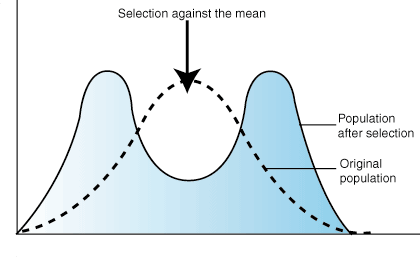
Figure 2
- Directional Selection – “In direction selection, one extreme of the trait distribution experience selection against it.” As a result of this selection, the population trait distribution shifts towards the other extreme. Considering the example of giraffe, there was the selection pressure against short necks as they were not able to reach the leaves of the trees. As a result, the distribution of length of neck was shifted in the favor of giraffes, i.e. the individuals with longer neck.
Following figure shows the effect of directional selection on trait distribution
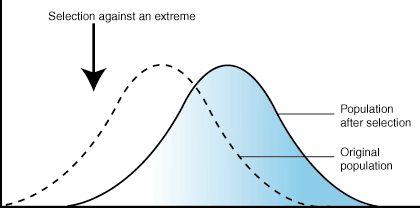
Figure 3
- Disruptive Selection – “In disruptive selection, selection pressures act against individuals in the middle of the trait distribution.” The outcome may be two peaked or bimodal. Consider an example of a plant with variable height pollinated by three different pollinators, i.e. one attracted to short plants, second attracted to medium plants and third visit only the tallest plant. If the pollinators which preferred plant height are disappeared from the area, medium height plants will be selected against the population of short and tall plants. Such a population, with several distinct forms is referred as polymorphic.
Following figure shows the effect of disruptive selection on trait distribution.
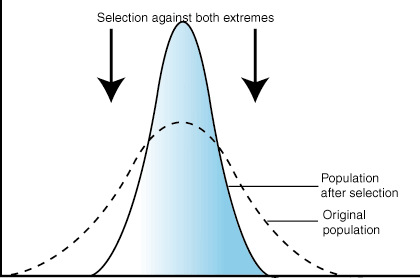
Figure 4
Darwin’s Theory of Evolution
This theory of evolution is one of the most substantiated theories in the science history because it is supported by wide variety of scientific disciplines i.e. geology, paleontology, developmental biology and genetics. The theory of evolution was first formulated by Charles Darwin in the year 1859. According to him, organisms change overtime behaviorally or physically. These changes allow the organisms to adapt to the environment such that they are able to survive and have more offspring.
The two main points of this theory are as follows –
- “All life on earth is connected and related to each other.”
- “The diversity of life is the product of modifications of population by natural selection.”
Modern understanding
Darwin was not aware of genetics, rather he observed only the pattern of evolution. After the discovery of genes, its importance, behavioral or physical traits and passing of genes were studied later. This resulted in corporation of genetics and Darwin’s theory which was termed as “Modern Evolutionary Synthesis.” According to this theory, the behavioral and physical change that occurs as a result of natural selection happens at DNA level and such changes are called mutations. Mutation can also cause random error in replication or repair of DNA due to radiation or chemical damage. In several cases, mutation can be neutral or harmful, while in some cases it also proves beneficial to the organisms.
Evolutionary Change
It is the constant process of gradual changes in physical or behavioral traits of organisms. It is the slow and continuous process. Evolutionary changes takes in following manner –
Catastrophism and Gradualism – Evolution includes change over the period of time. In catastrophism, the pattern of evolution is based on assumption that several catastrophic events separate the distinctive boundaries on fossil record. These catastrophes are floods, volcanic eruptions or droughts. This theory was proposed by George Cuvier. According to him, these catastrophic events have the local impact and thus, affect the organisms living in that specific area. Extinction of dinosaurs is considered as the result of catastrophic events.
On contrary to catastrophism, as per gradualism, changes take place continually over a long period of time. Thus, according to it, change did not occur as a result of huge event, rather it a gradual process whereby change takes place from generation to generation.
Human Evolution
“It is the evolutionary process that led to the emergence of anatomically modern humans.” The study of human evolution involves several scientific disciplines, such as primatology, anthropology, paleontology, archaeology, ethology, neurobiology, evolutionary psychology, linguistics, genetics and embryology.
Human evolution is a lengthy process and includes the change of present humans from ape like ancestors. As per the available scientific evidences, our behavioral and physical traits are originated from ape like ancestors and have gradually evolved over a period of approximately 6 million years.
Bipedalism (ability to walk on two legs) is one of the earliest defining traits which evolved 4 million years ago. Other characteristics like large and complex brain, capacity for language, ability to use and make tools, etc. were recently developed.
The process of Evolution
The process of evolution includes series of natural changes that cause species to arise, adapt to environment and become extinct. All organisms and species are the outcome of process of evolution. Evolution occurs with the change in genetic material that is inherited from parents. Here, genes represent “the segment of DNA that provide the chemical code for producing proteins.” Evolution does not change any single individual rather it changes the inherited means of growth and development. Parents pass genetic changes that are adapted to offspring and finally these changes become permanent or common throughout the population.
Frequently Asked Questions (FAQs)
Q1: Define mutation, migration and random genetic drift.
Answer: The term mutation is defined as “the spontaneous change in the gene frequency that takes place in population and occurs at low rate.”
“Migration is the local change in gene frequency when an individual moves from one population to another and then interbreeds.”
“Random genetic drift is the change that takes place from one generation to another by the process of pure chance.
Q2: How does the species evolve?
Answer: The changes in DNA takes place as it passes from one generation to another. DNA mutations sometimes affect the appearance of animals and sometimes the way in which boy works. Majority of times, the new version of gene survives better than an animal of old version and as per “survival of fittest” theory offspring adapt those changes and thus, evolution of species takes place.
Q3: What is adaptive radiation?
Answer: “In evolutionary biology, adaptive radiation is the process in which organisms diversify rapidly from an ancestral species into the multitude of new forms, particularly when a change in the environment makes new resources available, create new challenges or open new environmental niches.”

